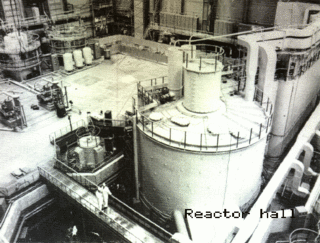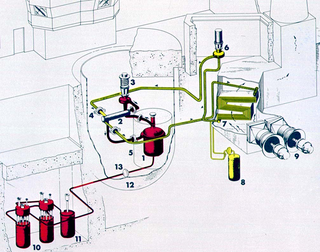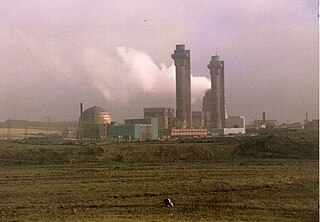Related Research Articles

A nuclear reactor, formerly known as an atomic pile, is a device used to initiate and control a fission nuclear chain reaction or nuclear fusion reactions. Nuclear reactors are used at nuclear power plants for electricity generation and in nuclear marine propulsion. Heat from nuclear fission is passed to a working fluid, which in turn runs through steam turbines. These either drive a ship's propellers or turn electrical generators' shafts. Nuclear generated steam in principle can be used for industrial process heat or for district heating. Some reactors are used to produce isotopes for medical and industrial use, or for production of weapons-grade plutonium. As of early 2019, the IAEA reports there are 454 nuclear power reactors and 226 nuclear research reactors in operation around the world.

The pebble-bed reactor (PBR) is a design for a graphite-moderated, gas-cooled nuclear reactor. It is a type of very-high-temperature reactor (VHTR), one of the six classes of nuclear reactors in the Generation IV initiative.

In nuclear engineering, a neutron moderator is a medium that reduces the speed of fast neutrons, ideally without capturing any, leaving them as thermal neutrons with only minimal (thermal) kinetic energy. These thermal neutrons are immensely more susceptible than fast neutrons to propagate a nuclear chain reaction of uranium-235 or other fissile isotope by colliding with their atomic nucleus.

The RBMK is a class of graphite-moderated nuclear power reactor designed and built by the Soviet Union. The name refers to its unusual design where, instead of a large steel pressure vessel surrounding the entire core, the core is surrounded by a cylindrical annular steel tank inside a concrete vault and each fuel assembly is enclosed in an individual 8 cm diameter pipe surrounded in graphite which allows the flow of cooling water around the fuel.
NRX was a heavy-water-moderated, light-water-cooled, nuclear research reactor at the Canadian Chalk River Laboratories, which came into operation in 1947 at a design power rating of 10 MW (thermal), increasing to 42 MW by 1954. At the time of its construction, it was Canada's most expensive science facility and the world's most powerful nuclear research reactor. NRX was remarkable both in terms of its heat output and the number of free neutrons it generated. When a nuclear reactor is operating its nuclear chain reaction generates many free neutrons, and in the late 1940s NRX was the most intense neutron source in the world.

Magnox is a type of nuclear power/production reactor that was designed to run on natural uranium with graphite as the moderator and carbon dioxide gas as the heat exchange coolant. It belongs to the wider class of gas-cooled reactors. The name comes from the magnesium-aluminium alloy used to clad the fuel rods inside the reactor. Like most other "Generation I nuclear reactors", the Magnox was designed with the dual purpose of producing electrical power and plutonium-239 for the nascent nuclear weapons program in Britain. The name refers specifically to the United Kingdom design but is sometimes used generically to refer to any similar reactor.

A fast-neutron reactor (FNR) or simply a fast reactor is a category of nuclear reactor in which the fission chain reaction is sustained by fast neutrons, as opposed to thermal neutrons used in thermal-neutron reactors. Such a reactor needs no neutron moderator, but requires fuel that is relatively rich in fissile material when compared to that required for a thermal-neutron reactor.

A loss-of-coolant accident (LOCA) is a mode of failure for a nuclear reactor; if not managed effectively, the results of a LOCA could result in reactor core damage. Each nuclear plant's emergency core cooling system (ECCS) exists specifically to deal with a LOCA.

The light-water reactor (LWR) is a type of thermal-neutron reactor that uses normal water, as opposed to heavy water, as both its coolant and neutron moderator – furthermore a solid form of fissile elements is used as fuel. Thermal-neutron reactors are the most common type of nuclear reactor, and light-water reactors are the most common type of thermal-neutron reactor.
Passive nuclear safety is a design approach for safety features, implemented in a nuclear reactor, that does not require any active intervention on the part of the operator or electrical/electronic feedback in order to bring the reactor to a safe shutdown state, in the event of a particular type of emergency. Such design features tend to rely on the engineering of components such that their predicted behaviour would slow down, rather than accelerate the deterioration of the reactor state; they typically take advantage of natural forces or phenomena such as gravity, buoyancy, pressure differences, conduction or natural heat convection to accomplish safety functions without requiring an active power source. Many older common reactor designs use passive safety systems to a limited extent, rather, relying on active safety systems such as diesel powered motors. Some newer reactor designs feature more passive systems; the motivation being that they are highly reliable and reduce the cost associated with the installation and maintenance of systems that would otherwise require multiple trains of equipment and redundant safety class power supplies in order the achieve the same level of reliability. However, weak driving forces that power many passive safety features can pose significant challenges to effectiveness of a passive system, particularly in the short term following an accident.

A molten salt reactor (MSR) is a class of nuclear fission reactor in which the primary nuclear reactor coolant and/or the fuel is a molten salt mixture. Only two MSRs have ever operated, both research reactors in the United States.
The Whiteshell Reactor No. 1, or WR-1, was a Canadian research reactor located at AECL's Whiteshell Laboratories (WNRL) in Manitoba. It was built to test the concept of a CANDU-type reactor that replaced the heavy water coolant with an oil substance. This had a number of potential advantages in terms of cost and efficiency.

The X-10 Graphite Reactor is a decommissioned nuclear reactor at Oak Ridge National Laboratory in Oak Ridge, Tennessee. Formerly known as the Clinton Pile and X-10 Pile, it was the world's second artificial nuclear reactor, and the first designed and built for continuous operation. It was built during World War II as part of the Manhattan Project.

The Molten-Salt Reactor Experiment (MSRE) was an experimental molten salt reactor at the Oak Ridge National Laboratory (ORNL) researching this technology through the 1960s; constructed by 1964, it went critical in 1965 and was operated until 1969.

The University of Florida Training Reactor (UFTR), commissioned in 1959, is a 100 kW modified Argonaut-type reactor at the University of Florida in Gainesville, Florida. The UFTR is a light water and graphite moderated, graphite reflected, light water cooled reactor designed and used primarily for training and nuclear research related activities. The UFTR is licensed by the Nuclear Regulatory Commission and is the only research reactor in Florida.

The liquid fluoride thorium reactor is a type of molten salt reactor. LFTRs use the thorium fuel cycle with a fluoride-based, molten, liquid salt for fuel. In a typical design, the liquid is pumped between a critical core and an external heat exchanger where the heat is transferred to a nonradioactive secondary salt. The secondary salt then transfers its heat to a steam turbine or closed-cycle gas turbine.

The Materials Testing Reactor (MTR) was an early nuclear reactor specifically designed to facilitate the conception and design of future reactors. It produced much of the foundational irradiation data that underlies the nuclear power industry. It operated in Idaho at the National Reactor Testing Station from 1952 to 1970.

The Windscale Piles were a pair of air-cooled graphite-moderated nuclear reactors on the northwest coast of England in Cumberland. The two reactors, referred to at the time as "piles", were built as part of the British post-war atomic bomb project.
High Flux Beam Reactor (HFBR) was a research reactor which was located at Brookhaven National Laboratory, a United States Department of Energy national laboratory located in Upton, New York, on Long Island, approximately 60 miles east of New York City. A successor to the Brookhaven Graphite Research Reactor, the HFBR operated from 1965 until 1996 and has been partially decommissioned.
Medical Research Reactor (MRR) was a research reactor which was located at Brookhaven National Laboratory, a United States Department of Energy national laboratory located in Upton, New York, on Long Island, approximately 60 miles east of New York City. The second of three reactors constructed at BNL, the MRR operated from 1959 until 2000 and has been partially decommissioned.
References
- ↑ "Nuclear physics at the University of Manchester". Archived from the original on 5 March 2008. Retrieved 4 March 2008.
- ↑ "BNFL decommissioning note" (PDF). Archived from the original (PDF) on 10 November 2006. Retrieved 4 March 2008.
- ↑ Razey, M. (1964). "The Universities Research Reactor". Electronics and Power. 10 (10): 372. doi:10.1049/ep.1964.0359. ISSN 0013-5127.
- ↑ E., HUMPHREYS; K., RIDING (1994). "Stages 1&2 Decommissioning of the Universities Research Reactor(URR), Risley". Nuclear Engineer. 35 (5): 154–157. ISSN 0262-5091.